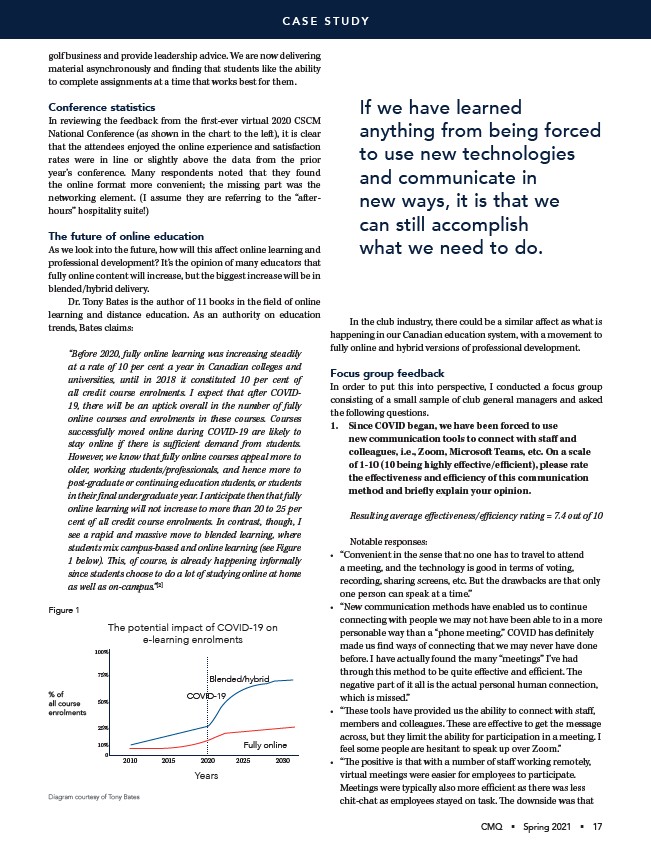
CASE STUDY
golf business and provide leadership advice. We are now delivering
material asynchronously and finding that students like the ability
to complete assignments at a time that works best for them.
Conference statistics
In reviewing the feedback from the first-ever virtual 2020 CSCM
National Conference (as shown in the chart to the left), it is clear
that the attendees enjoyed the online experience and satisfaction
rates were in line or slightly above the data from the prior
year’s conference. Many respondents noted that they found
the online format more convenient; the missing part was the
networking element. (I assume they are referring to the “afterhours”
hospitality suite!)
The future of online education
As we look into the future, how will this affect online learning and
professional development? It’s the opinion of many educators that
fully online content will increase, but the biggest increase will be in
blended/hybrid delivery.
Dr. Tony Bates is the author of 11 books in the field of online
learning and distance education. As an authority on education
trends, Bates claims:
“Before 2020, fully online learning was increasing steadily
at a rate of 10 per cent a year in Canadian colleges and
universities, until in 2018 it constituted 10 per cent of
all credit course enrolments. I expect that after COVID-
19, there will be an uptick overall in the number of fully
online courses and enrolments in these courses. Courses
successfully moved online during COVID-19 are likely to
stay online if there is sufficient demand from students.
However, we know that fully online courses appeal more to
older, working students/professionals, and hence more to
post-graduate or continuing education students, or students
in their final undergraduate year. I anticipate then that fully
online learning will not increase to more than 20 to 25 per
cent of all credit course enrolments. In contrast, though, I
see a rapid and massive move to blended learning, where
students mix campus-based and online learning (see Figure
1 below). This, of course, is already happening informally
since students choose to do a lot of studying online at home
as well as on-campus.”2
Figure 1
% of
all course
enrolments
The potential impact of COVID-19 on
100%
75%
50%
25%
10%
0
e-learning enrolments
Blended/hybrid
2010 2015 2020 2025 2030
Years
Fully online
COVID-19
Diagram courtesy of Tony Bates
If we have learned
anything from being forced
to use new technologies
and communicate in
new ways, it is that we
can still accomplish
what we need to do.
In the club industry, there could be a similar affect as what is
happening in our Canadian education system, with a movement to
fully online and hybrid versions of professional development.
Focus group feedback
In order to put this into perspective, I conducted a focus group
consisting of a small sample of club general managers and asked
the following questions.
1. Since COVID began, we have been forced to use
new communication tools to connect with staff and
colleagues, i.e., Zoom, Microsoft Teams, etc. On a scale
of 1-10 (10 being highly effective/efficient), please rate
the effectiveness and efficiency of this communication
method and briefly explain your opinion.
Resulting average effectiveness/efficiency rating = 7.4 out of 10
Notable responses:
• “Convenient in the sense that no one has to travel to attend
a meeting, and the technology is good in terms of voting,
recording, sharing screens, etc. But the drawbacks are that only
one person can speak at a time.”
• “New communication methods have enabled us to continue
connecting with people we may not have been able to in a more
personable way than a “phone meeting.” COVID has definitely
made us find ways of connecting that we may never have done
before. I have actually found the many “meetings” I’ve had
through this method to be quite effective and efficient. The
negative part of it all is the actual personal human connection,
which is missed.”
• “These tools have provided us the ability to connect with staff,
members and colleagues. These are effective to get the message
across, but they limit the ability for participation in a meeting. I
feel some people are hesitant to speak up over Zoom.”
• “The positive is that with a number of staff working remotely,
virtual meetings were easier for employees to participate.
Meetings were typically also more efficient as there was less
chit-chat as employees stayed on task. The downside was that
CMQ § Spring 2021 § 17